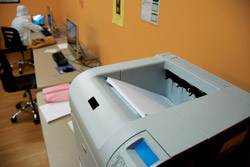News
Printing charges in Eads ArtSci lab drive paper use up in residential labs, STS says

Printing on the South 40 has increased considerably after the implementation of a printing fee in Eads.
Students on the South 40 need to continue cutting back on paper usage, according to administrators at Student Technology Services (STS). Although PaperCut software is being used in these residential areas, there has actually been a substantial increase in the amount of printing done in residential computer labs this year.
The PaperCut monitoring software is used on main campus and in the residential areas. The labs use the program, in which students have to log in to print, to dissuade students from printing more than is necessary. While the labs on main campus charge for printing, printing in dorm computer labs run by STS remains free.
Barbara Braun, the director of STS, believes that the increase in printing is at least partially due to the newly instated charges for printing on campus. She believes that students are turning to the residential computing labs for free printing instead of paying for printing on campus.
Last academic year, about 2.25 million sheets of paper were used in the residential printing labs. This year, Braun predicts that the number will be higher than 3 million.
“PaperCut helps us manage printing and cut down on waste,” Braun said. “It does not cut down on printing. Only students can do that.”
The week of March 14, 80,000 sheets of paper were used in residential printing facilities.
In the month of February alone, 29,992 sheets of paper were used in the Dardick computer lab. According to STS, this is equivalent to using 37 percent of a tree, leaving a light bulb on for 8,512 hours or emitting 258 pounds of carbon dioxide.
Braun said there are things that students can do to decrease the amount of paper being used in these computer labs. Documents are already printed double sided. Students can print two pages per sheet of paper, which would halve the number of pages printed.
The Student Technology Advisory Committee (STAC) has started to e-mail the top 10 users of paper each week to notify them of the high volume of paper they are using.
According to Braun, this is to help the “resources to be allocated evenly.”
The volume of paper used, particularly given the University’s reputation as an environmentally conscious campus, surprises students and members of the University community. Even so, students recognize the amount of printing that is necessary for many classes.
“We use a lot of paper,” freshman Sarah Garay said. “I wish that teachers would be more willing to let you bring your laptops into class. It could cut down a lot on paper use.”
Senior Cristina Woodhouse lives off campus. She finds the newly instated charges for the Arts & Sciences printers to be inconvenient because she no longer has a source of free printing.
Adjusting to printing less has been a learning process for many students who live off campus.
“It is inconvenient, but it is probably helping the environment, which is something we should all learn to do anyway,” Woodhouse said.
Even though printing on the 40 increased this year, the University’s newly implemented printing software, and charges, have been effective in reducing printing on campus.
Earlier this year, the University campus ushered in a series of changes with its printing programs. Both on main campus and in the residential areas, the PaperCut software was installed on computers.
For the first time, students have been charged to use the Arts & Sciences computing labs. Prior to this, students in Arts & Sciences could use the lab in Eads to avoid the library’s printing charges.
According to Marcia Mannen, associate director for client support of Arts & Sciences computing, charging students to print has caused a substantial decrease in the amount of paper wasted every day.
Last year, students would sometimes leave the labs rather than wait for their print jobs to finish, and they would come back later to reprint. As a result, about 500 pages were abandoned in the Eads labs every week. This year, 10-20 sheets are left in the lab every week.
According to Mannen, 516,572 sheets of paper were printed in the Eads printing facilities in the fall 2008 semester. In contrast, 74,796 sheets were printed last term after the charges were instated.
The business and engineering schools also started to use the PaperCut software this semester, though their allowed printing quotas are higher.
